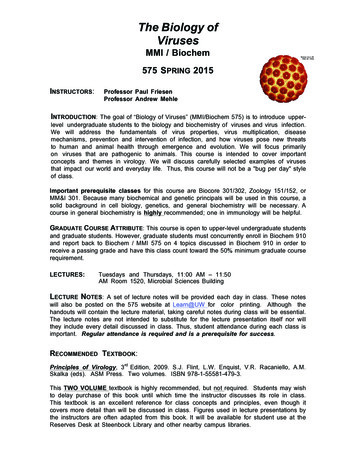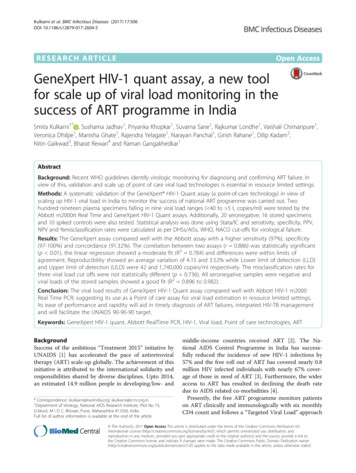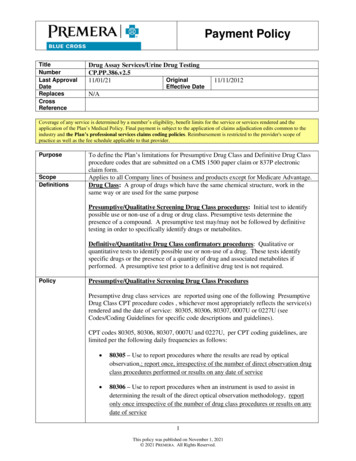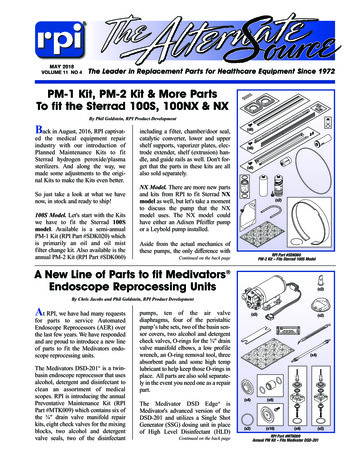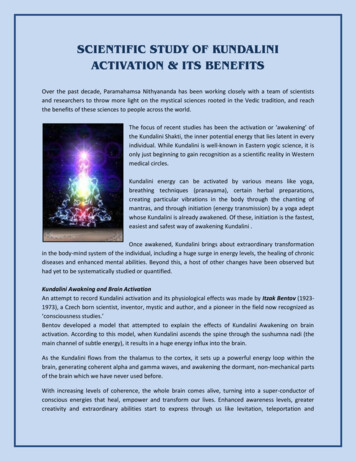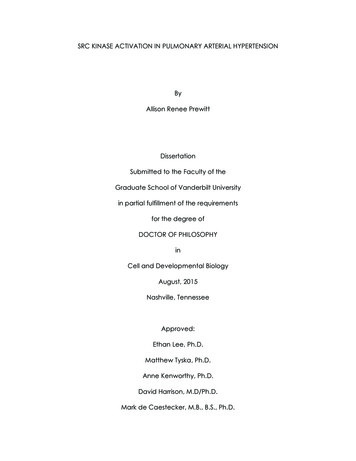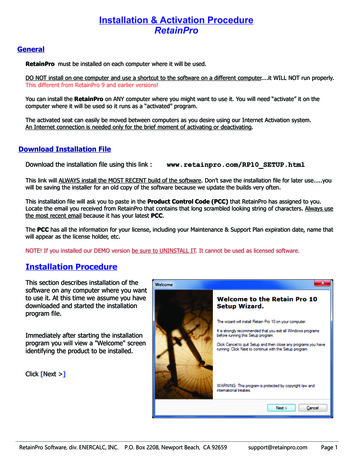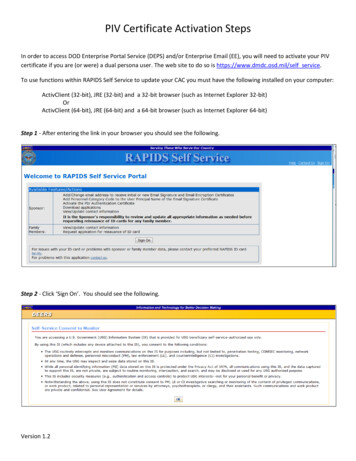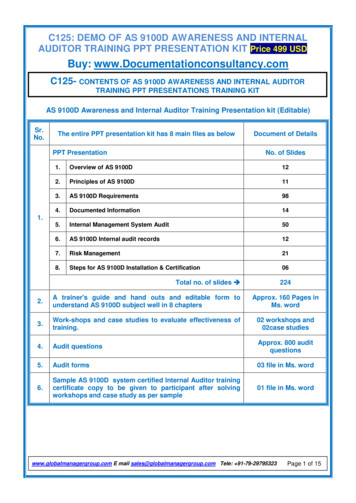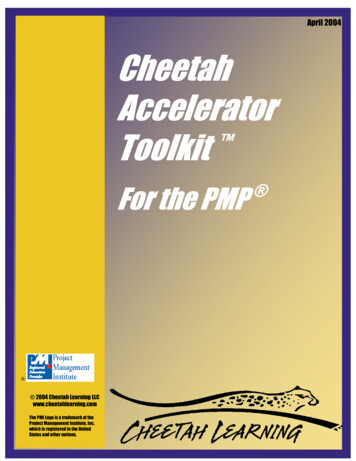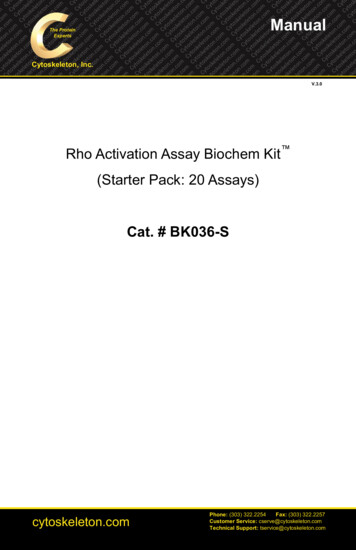
Transcription
ManualThe ProteinExpertsCytoskeleton, Inc.V.3.0Rho Activation Assay Biochem Kit (Starter Pack: 20 Assays)Cat. # BK036-Scytoskeleton.comPhone: (303) 322.2254Fax: (303) 322.2257Customer Service: cserve@cytoskeleton.comTechnical Support: tservice@cytoskeleton.com
cytoskeleton.comPage 2
Manual ContentsSection I: IntroductionBackground- Rho Activation Assay ------------------------------------------------ 5Section II: Purchaser Notification ----------- 6Section III: Kit Contents ------------------------ 7-8Section IV: Reconstitution and Storage of Components ----------------------------- 9Section V: Important Technical NotesA. Notes on Updated Version - 10B. Growth and Treatment of Cell Lines ---------------------------------------- 10-11C. Timing and Intensity of Rho Activation ------------------------------------- 11D. Rapid Processing of Cells --- 12-13E. Protein Concentration Equivalence ----------------------------------------- 13F. Assay Linearity ----------------- 13-14Section VI: Assay ProtocolSTEP 1: Control Reactions -------- 15STEP 2: Lysate Collection --------- 16-17STEP 3: Pulldown Assay ---------- 18STEP 4: Western Blot ----------- 19Section VII: Troubleshooting ----------------- 20-21Section VIII: References ------------------------ 22APPENDICESAppendix 1 Serum Starving Cells and F-actin Visualization ----------------------------- 23-24Appendix 2 Table of Known Rho Activators -------------------------------------------------- 25Appendix 3 Protein Quantitation (with precision Red) ------------------------------------- 26-27Appendix 4 Total RhoA ELISA ----------------- 28-29Appendix 5 Processing tissue samples for pull-down assays -------------------------- 30cytoskeleton.comPage 3
cytoskeleton.comPage 4
I: IntroductionBackground– Rho Activation AssayThe Rho family of small GTPases consists of at least 20 members, the most extensivelycharacterized of which are the Rac1, RhoA and Cdc42 proteins (1-4). In common with all othersmall G-proteins, the Rho proteins act as molecular switches that transmit cellular signalsthrough an array of effector proteins. This family mediates a diverse number of cellularresponses including cytoskeletal reorganization (1-4), regulation of transcription (5), DNAsynthesis, membrane trafficking and apoptosis (6-9).The Rho switch operates by alternating between an active, GTP-bound state and an inactive,GDP-bound state (10-12). Understanding the mechanisms that regulate activation / inactivationof the GTPases is of obvious biological significance and is a subject of intense investigation.The fact that Rho family effector proteins will specifically recognize the GTP bound form of theprotein (13) has been exploited experimentally to develop a powerful affinity purification assaythat monitors Rho protein activation (14).This assay uses the Rho binding domain (also called the RBD) of the Rho effector proteinrhotekin. The RBD protein motif has been shown to bind specifically to the GTP-bound form ofRho. The fact that the RBD region of rhotekin has a high affinity for GTP-Rho makes it an idealtool for affinity purification of GTP-Rho from cell lysates. The rhotekin-RBD protein supplied inthis kit contains amino acids 7-89 of rhotekin RBD expressed as GST fusion in E.coli bound tocolored glutathione-sepharose beads. This allows one to “pulldown” GTP-Rho complexed withrhotekin-RBD beads. This assay provides a simple means of analyzing cellular Rho activities ina variety of systems. The amount of activated Rho is determined by a Western blot using a Rhospecific antibody. A typical Rho pulldown assay using GTP and GDP loaded human plateletextract or Swiss 3T3 cell extracts is shown in Figure 1.Figure 1. Rhotekin-RBD bead pulldown Assays.A. Extract (300 μg) from human platelet cells was loadedwith GTPγS (GTP lane) or GDP (GDP lane) using themethod described in Section VI: Control Reactions.B. Extract (300 μg) from serum starved (SS) andsubsequent calpeptin (CAL) treated Swiss 3T3 cells. Allextracts were incubated with 50 μg of rhotekin-RBD beadsand processed as described in Section VI: Pulldown Assay.All bead samples were resuspended in 10 µl of 2x samplebuffer and run on a 12% SDS gel. Protein was transferredto PVDF, probed with a 1:500 dilution of anti-RhoA andprocessed for chemiluminescent detection as described inSection VI: Western Blot Protocol.cytoskeleton.comPage 5
II: Purchaser NotificationLimited Use StatementThe purchase of this product conveys to the buyer the non-transferable right to use thepurchased amount of product and components of product in research conducted by thebuyer. The buyer cannot sell or otherwise transfer this product or any component thereofto a third party or otherwise use this product or its components for commercial purposes.Commercial purposes include, but are not limited to: use of the product or itscomponents in manufacturing; use of the product or its components to provide a service;resale of the product or its components.The terms of this Limited Use Statement apply to all buyers including academic and forprofit entities. If the purchaser is not willing to accept the conditions of this Limited UseStatement, Cytoskeleton Inc. is willing to accept return of the unused product with a fullrefund.This kit contains enough reagents for approximately 20 pulldown assays.cytoskeleton.comPage 6
III: Kit ContentsTable 1: Kit Contents and Storage Upon ArrivalReagentsCat. # or Part # * QuantityStorageRhotekin RBDbeadsPart # RT02-SDesiccated 4 CAnti-RhoAmonoclonalantibody IgMCat # ARH051 tube, lyophilizedDesiccated 4 CHis-RhoA controlproteinPart # RHWT1 tube, lyophilized;Desiccated 4 CCell Lysis BufferPart # CLB01-S2 tubes, lyophilized;0.5 mg of protein per tubebound to coloredsepharose beads10 µg protein ( 30 kDa) asa Western Blot standard.1 bottle, lyophilized;Desiccated 4 C50mM Tris pH 7.5, 10mMMgCl2, 0.5M NaCl, and 2%Igepal when reconstitutedWash BufferPart # WB01-S1 bottle, lyophilized;Desiccated 4 C25 mM Tris pH 7.5, 30 mMMgCl2, 40 mM NaCl whenreconstitutedLoading BufferPart # LB011 tube, 1 ml;4 C150 mM EDTA solutionSTOP BufferPart # STP011 tube, 1 ml;4 C600 mM MgCl2 solutionGTPγS stock: (non Cat # BS01-hydrolysable GTPanalog)1 tube, lyophilized;GDP stock1 tube, lyophilized;Part # GDP01Desiccated 4 C20 mM solution whenreconstitutedDesiccated 4 C100 mM solution whenreconstitutedProtease InhibitorCocktailCat. # PIC021 tube, lyophilized; 100XDesiccated 4 Csolution: 62 µg/mlLeupeptin, 62 µg/mlPepstatin A, 14 mg/mlBenzamidine and 12 mg/mltosyl arginine methyl esterwhen reconstitutedDMSOPart # DMSO1 tube, 1.5ml.4 (will freeze at 4 C)Solvent for proteaseinhibitor cocktail* Items with part numbers (Part #) are not sold separately and available only in kitformat. Items with catalog numbers (Cat. #) are available separately.The reagents and equipment that you will require but are not supplied:cytoskeleton.comPage 7
III: Kit Contents (Continued) Cell lysate (see Section V: B-D and Section VI: Step 2) 2X Laemmli sample buffer (125mM Tris pH 6.8, 20% glycerol, 4% SDS, 0.005%Bromophenol blue, 5% beta-mercaptoethanol) Polyacrylamide gels (12% or 4-20% gradient gels) SDS-PAGE buffers Western blot buffers (see Section VI: Step 4) Protein transfer membrane (PVDF or Nitrocellulose) Secondary antibody (e.g. Goat anti-mouse HRP conjugated IgG, Jackson Labs.Cat# 115-035-068) Chemiluminescence based detection system (e.g. SuperSignal West Dura ExtendedDuration Substrate; ThermoFisher) Cell scrapers Liquid nitrogen for snap freezing cell lysatescytoskeleton.comPage 8
IV: Reconstitution and Storage of ComponentsMany of the components of this kit have been provided in lyophilized form. Prior tobeginning the assay you will need to reconstitute several components as detailed in Table2. When properly stored and reconstituted, components are guaranteed stable for 6months.Table 2: Component Storage and ReconstitutionKit BD ProteinBeadsReconstitute each tube with 300 µl distilled water. Store at –70 C.Aliquot into 10 x 30 µl volumes (30 µl of beads 50 µg ofprotein, under these conditions the two tubes of 300 µlare sufficient for 20 assays).Snap freeze in liquid nitrogen.Anti-RhoA monoclonalIgM antibodyResuspend in 200 µl of PBS. Use at 1:500 dilution.Store at 4 C.His-RhoA control protein Reconstitute in 30 µl of distilled water. Aliquot into 10 x3 µl sizes and snap freeze in liquid nitrogen.Store at –70 C.Cell Lysis BufferStore at 4 CReconstitute in 30 ml of sterile distilled water.This solution may take 5-10 min to resuspend. Use a 10ml pipette to thoroughly resuspend the buffer.Wash BufferReconstitute in 30 ml of sterile distilled water.Store at 4 CLoading BufferNo reconstitution necessary.Store at 4 CSTOP BufferNo reconstitution necessaryStore at 4 CGTPγS stock (nonhydrolysable GTPanalog)Reconstitute in 50 µl of sterile distilled water. Aliquot Store at –70 Cinto 5 x 10 µl volumes, snap freeze in liquid nitrogen.GDP StockReconstitute in 50 µl of sterile distilled water. Aliquot Store at –70 Cinto 5 x 10 µl volumes, snap freeze in liquid nitrogen.Protease InhibitorCocktailReconstitute in 1 ml of dimethyl sulfoxide (DMSO) for Store at –20 C.100x stock.cytoskeleton.comPage 9
V: Important Technical NotesA)Notes on Updated Version 3.0The following updates should be noted:The RhoA Antibody has been changed from part #ARH04 (Mab IgG) to ARH05 (MabIgM) . ARH05 is a monoclonal anti-RhoA specific antibody. It has the same specificity asCat# ARH04 and was found to give a more robust signal than ARH04. NOTE: use asecondary antibody that recognizes mouse IgM.B)Growth and Treatment of Cell LinesThe health and responsiveness of your cell line is the single most important parameter forthe success and reproducibility of Rho activation assays. Time should be taken to readthis section and to carefully maintain cell lines in accordance with the guidelines givenbelow.Adherent fibroblast cells such as 3T3 cells should be ready at 30% confluency or for nonadherent cells, at approximately 3 x 105 cells per ml. Briefly, cells are seeded at 5 x 10 4cells per ml and grown for 3-5 days. Serum starvation (see below) or other treatmentshould be performed when cells are approximately 30% confluent. It has been found thatcells cultured for several days (3-5 days) prior to treatment are significantly moreresponsive than cells that have been cultured for a shorter period of time. Other celltypes may require a different optimal level of confluency to show maximumresponsiveness to Rho activation. Optimal confluency prior to serum starvation andinduction should be determined for any given cell line (also see Appendix 2 for cell linespecific references).When possible, the untreated samples should have cellular levels of Rho activity in a“controlled state”. For example, when looking for Rho activation, the “controlled state”cells could be serum starved. Serum starvation will inactivate cellular Rho and lead to amuch greater response to a given Rho activator. A detailed method for serum starvationis given in Appendix 1.Cells should also be checked for their responsiveness (“responsive state”) to a knownstimulus. A list of known Rho stimuli are given in Appendix 2. In many cases poorculturing technique can result in essentially non-responsive cells. An example of poorculturing technique includes the sub-culture of cells that have previously been allowed tobecome overgrown. For example, Swiss 3T3 cells grown to 70% confluency should notbe used for Rho activation studies.To confirm the “controlled state” and “responsive state” of your cells, it is a good idea toinclude a small coverslip in your experimental tissue culture vessels and analyze the“controlled state” cells versus the “responsive state” cells by rhodamine phalloidin stainingof actin filaments. A detailed method for actin staining is given in Appendix 1. Figure 2shows rhodamine phalloidin stained Swiss 3T3 cells that have been serum starved (A)and calpeptin (Cat. # CN01) stimulated (B). Rho activation by calpeptin causes theformation of characteristic stress fibers.cytoskeleton.comPage 10
V: Important Technical Notes (Continued)Figure 2:CellsRhodamine Phalloidin Stained Serum-Starved and Calpeptin-TreatedABSwiss 3T3 cells were grown at 37 C, 5% CO2 and 95% humidity in 100 mm dishes containing a smallglass coverslip. Cells were grown in Dulbecco’s modified Eagle’s medium plus 10% calf bovineserum to 30% confluency. For serum starvation, media was changed to 0.5% calf bovine serum for24 h then to 0% calf bovine serum for a further 24 h. After this time, one dish was treated with calpeptin (Cat. # CN01; 0.1 mg/ml final) for 20-30 min and the other dish treated with carrier only(DMSO). After incubation, the coverslips were removed from the dishes and stained with rhodaminephalloidin (A, serum starved cells; B, calpeptin treated cells). The remaining cells were lysed andprocessed in a G-LISA assay. G-LISA results showed calpeptin treated cells expressed 2 fold theRho activity of the serum starved cells (data not shown).If you are having difficulty determining a “controlled state” for your experiment thencontact technical assistance at 303-322-2254 or e-mail tservice@cytoskeleton.com.C)Timing and Intensity of Rho ActivationUpon stimulation, Rho proteins are generally activated very rapidly and transiently
Cat # BS01 1 tube, lyophilized; 20 mM solution when reconstituted Desiccated 4 C GDP stock Part # GDP01 1 tube, lyophilized; 100 mM solution when reconstituted Desiccated 4 C Protease Inhibitor Cocktail Cat. # PIC02 1 tube, lyophilized; 100X solution: 62 µg/ml Leupeptin, 62 µg/ml Pepstatin A, 14 mg/ml Benzamidine and 12 mg/ml
